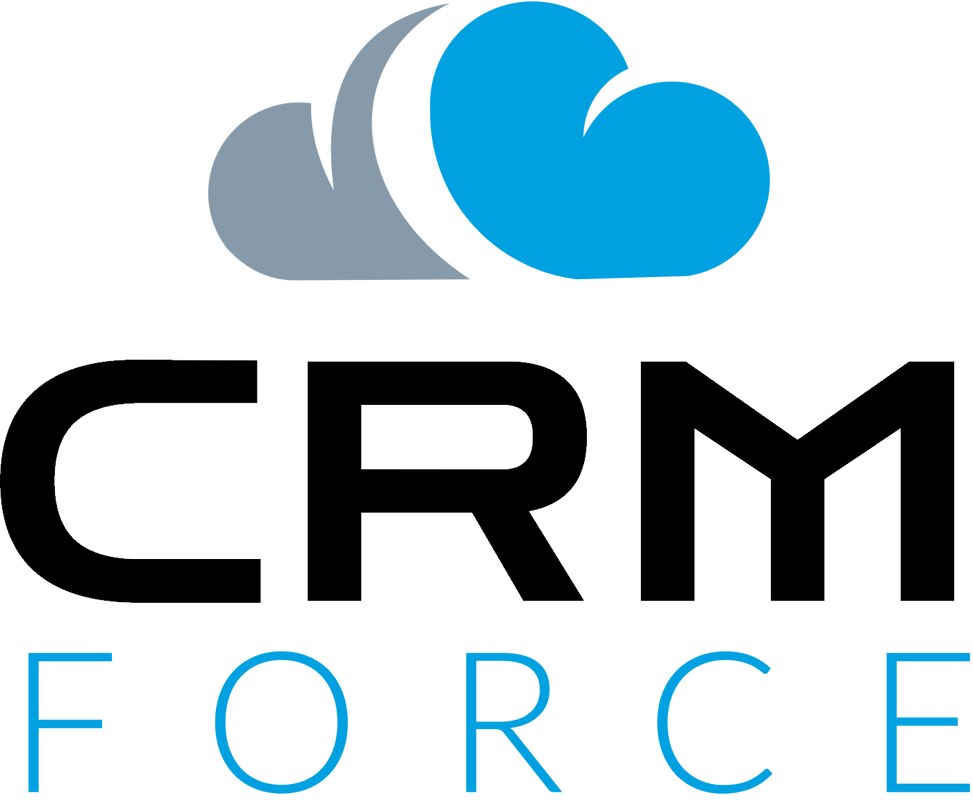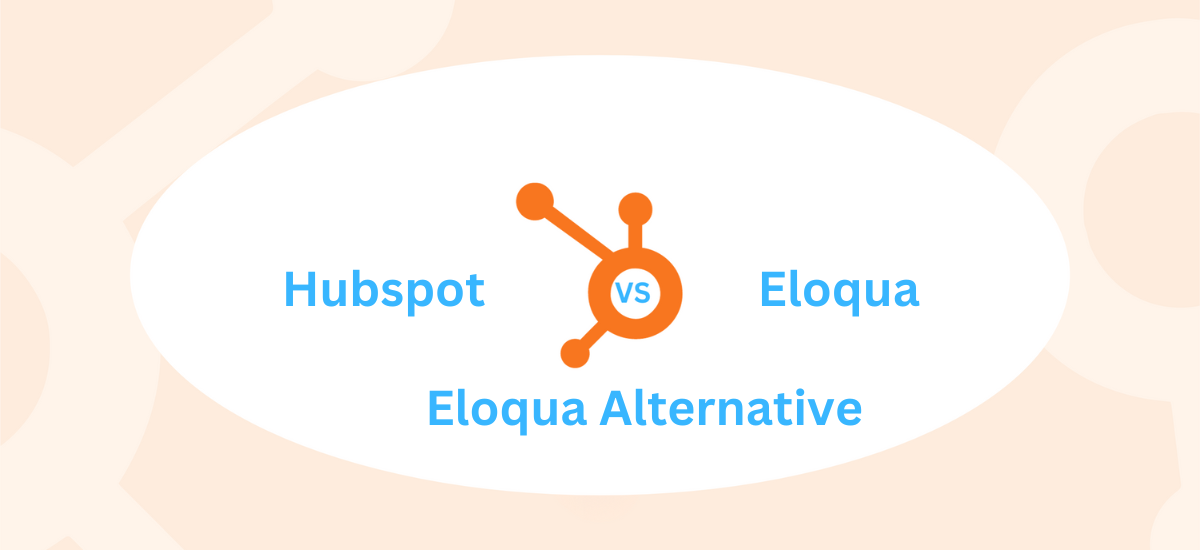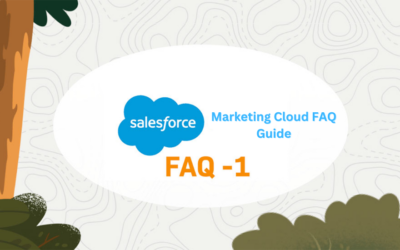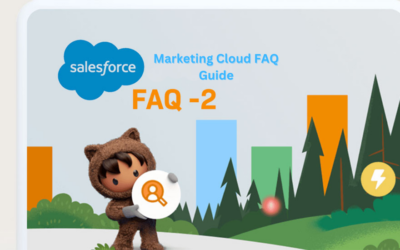In the dynamic landscape of digital marketing, where precision and efficiency reign supreme, businesses are continually seeking innovative solutions to elevate their strategies. At the forefront of this evolution stand marketing automation platforms, indispensable tools that empower organizations to streamline processes, engage leads, and optimize their overall marketing endeavors. As we mark the one-year milestone of exploring the intricate facets of technology and business, we turn our attention to a compelling and decisive comparison: HubSpot vs. Eloqua. These industry giants have etched their places as frontrunners in the marketing automation realm, each boasting a unique set of features and technical capabilities. In this comprehensive guide, we embark on a journey of exploration and analysis, dissecting the intricate technicalities of HubSpot and Eloqua to provide businesses with the insights they need to make informed decisions. From user interfaces and feature showdowns to scalability and analytics, our goal is to equip readers with the knowledge necessary to navigate the complex landscape of marketing automation and propel their strategies to new heights.
As we delve into the depths of this comparison, it’s crucial to recognize the profound impact that marketing automation has had on reshaping the digital marketing paradigm. Gone are the days of manual, time-consuming tasks; in their place, automation platforms promise efficiency, data-driven decision-making, and a holistic approach to customer engagement. With a focus on technical nuances and innovation, this guide aims to unravel the mysteries behind HubSpot and Eloqua, offering not just a superficial comparison but a deep dive into the technical underpinnings that make these platforms the powerhouses they are. Whether you’re a startup looking for user-friendly automation or a large enterprise navigating the complexities of multi-channel campaigns, the next chapters will unravel the technical tapestry of HubSpot and Eloqua, providing you with the insights needed to chart your course in the ever-evolving landscape of digital marketing automation. If you need assistance with Salesforce CRM setup and optimization, companies like CRM Force can provide valuable expertise and support.
1- Understanding HubSpot
HubSpot, a powerhouse in the realm of marketing automation, has gained widespread recognition for its comprehensive suite of tools designed to streamline inbound marketing efforts. At its core, HubSpot offers a user-friendly interface that caters to marketers of varying technical expertise. The platform’s dashboard is intuitively designed, providing a centralized hub for managing various aspects of marketing campaigns.
A- HubSpot’s Inbound Marketing Focus
HubSpot’s forte lies in its emphasis on inbound marketing methodologies. This approach involves creating valuable content to attract and engage prospects, ultimately converting them into loyal customers. The platform seamlessly integrates content creation, social media management, and lead generation, allowing businesses to execute holistic inbound strategies.
B- Robust Analytics Capabilities
One of HubSpot’s standout features is its analytics suite, which empowers marketers with data-driven insights. Users can track the performance of their campaigns, monitor website traffic, and assess the effectiveness of individual marketing assets. This data-driven approach enables marketers to refine their strategies continually, ensuring optimal results.
C- Integration with CRM Systems
HubSpot’s integration with Customer Relationship Management (CRM) systems enhances its capabilities in lead tracking and management. The platform’s CRM functionality allows for a unified view of customer interactions, ensuring seamless communication between marketing and sales teams. This integration is particularly valuable for businesses aiming to align their marketing and sales efforts cohesively.
D- Personalization and Lead Nurturing
HubSpot excels in personalization, allowing marketers to tailor their messages based on user behavior, demographics, and interactions. The platform’s lead nurturing capabilities enable businesses to automate the process of guiding leads through the sales funnel, delivering targeted content at each stage to nurture prospects until they are ready for conversion.
E- Scalability and Flexibility
HubSpot caters to businesses of all sizes, making it a versatile solution for startups, small businesses, and even larger enterprises. Its scalability ensures that as businesses grow, they can seamlessly adapt and expand their use of HubSpot without facing significant hurdles.
F- User Training and Certification
To empower users with the skills needed to leverage HubSpot effectively, the platform provides comprehensive training resources and certifications. These include online courses, documentation, and a supportive community. Marketers can enhance their proficiency in utilizing the platform’s features, ensuring they extract maximum value from their investment in HubSpot.
G- Constant Updates and Innovation
HubSpot maintains its competitive edge through regular updates and innovations. The platform evolves to meet the dynamic needs of the digital marketing landscape, incorporating new features and functionalities. This commitment to innovation ensures that users stay ahead of the curve in an ever-changing environment.
2- Eloqua – The Oracle of Marketing Automation
Eloqua, a cornerstone of Oracle’s marketing cloud, stands as a robust marketing automation platform designed to meet the intricate needs of large enterprises. This chapter will dissect the technical aspects that set Eloqua apart, showcasing its advanced features, multi-channel capabilities, and comprehensive reporting functionalities.
A- Advanced Lead Scoring
Eloqua’s prowess in lead scoring is a technical cornerstone of the platform. The system employs a sophisticated algorithm that assigns scores to leads based on their interactions with marketing assets and engagement with the brand. This dynamic scoring system enables businesses to prioritize and focus their efforts on leads that exhibit a higher likelihood of conversion.
B- Multi-Channel Campaign Management
Eloqua excels in managing multi-channel marketing campaigns, allowing enterprises to orchestrate cohesive strategies across various channels. The platform supports email marketing, social media, web, and mobile channels, providing a unified interface for planning, executing, and analyzing campaigns. This technical versatility ensures that enterprises can maintain a consistent brand message across diverse touchpoints.
C- Comprehensive Reporting and Analytics
At the heart of Eloqua’s technical capabilities lies its comprehensive reporting and analytics suite. The platform empowers users with granular insights into campaign performance, lead behavior, and conversion metrics. Eloqua’s reporting tools enable users to create custom reports, visualize data trends, and make data-driven decisions to optimize their marketing strategies continually.
D- Dynamic Content Personalization
Eloqua’s dynamic content personalization features leverage data to deliver tailored content to individual prospects. Through the use of dynamic content blocks, the platform enables marketers to customize messages based on various parameters such as industry, job role, or previous interactions. This technical capability enhances the relevance of marketing communications, fostering deeper engagement.
E- Integration with CRM and Third-Party Systems
For large enterprises with complex tech stacks, integration capabilities are paramount. Eloqua seamlessly integrates with Customer Relationship Management (CRM) systems and a variety of third-party applications. This technical interoperability ensures a unified view of customer data across the organization, facilitating seamless collaboration between marketing, sales, and other departments.
F- Scalability for Enterprise-level Demands
Eloqua’s technical architecture is engineered to meet the demands of large enterprises. The platform’s scalability allows it to handle extensive databases, high-volume campaigns, and complex automation workflows. Eloqua is designed to grow alongside the enterprise, ensuring that its technical capabilities remain robust as the business expands.
G- Security and Compliance
Given the sensitivity of marketing data, Eloqua places a strong emphasis on security and compliance. The platform adheres to industry standards and regulations, implementing robust security measures to safeguard customer data. Eloqua’s technical infrastructure is designed to provide a secure environment for businesses operating in highly regulated industries.
H- AI and Machine Learning Capabilities
Eloqua harnesses the power of artificial intelligence (AI) and machine learning to enhance its technical capabilities. These technologies contribute to predictive analytics, dynamic content optimization, and advanced segmentation. The platform’s AI-driven features empower marketers to make data-driven decisions and optimize their campaigns with greater precision.
3- Feature-by-Feature Showdown
In this technical exploration, we’ll conduct a detailed feature-by-feature comparison between HubSpot and Eloqua. Understanding the nuances of each platform’s capabilities is crucial for businesses aiming to align their marketing automation choice with their specific requirements. Let’s delve into the technical aspects of key features, dissecting the strengths and potential drawbacks of both HubSpot and Eloqua.
A- Email Marketing Automation
HubSpot: HubSpot’s email marketing automation tools are renowned for their user-friendly interface and comprehensive functionalities. The platform offers drag-and-drop email builders, A/B testing, and personalization options. HubSpot’s technical prowess lies in its automation workflows, allowing users to create intricate sequences based on user behavior and engagement metrics.
Eloqua: Eloqua’s email marketing automation is geared towards enterprise-level precision. The platform excels in dynamic content personalization, utilizing data-driven insights to tailor emails for individual recipients. Eloqua’s technical capabilities extend to advanced segmentation, ensuring that emails are targeted with precision, a crucial aspect for large-scale campaigns.
B- Lead Nurturing
HubSpot: HubSpot’s lead nurturing features are built on the foundation of inbound marketing principles. The platform allows for the creation of automated workflows that nurture leads based on their interactions with content. HubSpot’s technical strength in lead nurturing lies in its ability to seamlessly integrate with CRM systems, ensuring a unified approach to lead management.
Eloqua: Eloqua’s lead nurturing capabilities are highly sophisticated, driven by advanced lead scoring algorithms. The platform’s technical intricacies allow for the creation of personalized nurture tracks, adjusting the content and cadence based on lead behavior. Eloqua’s dynamic lead nurturing is particularly suited for enterprises with complex sales cycles.
C- Social Media Integration
HubSpot: HubSpot’s technical integration with social media platforms is user-friendly yet robust. The platform allows for scheduling posts, monitoring social engagement, and tracking the effectiveness of social campaigns. HubSpot’s analytics provide insights into social media performance, contributing to a comprehensive view of the overall marketing strategy.
Eloqua: Eloqua integrates social media into its multi-channel campaign management seamlessly. The platform’s technical capabilities enable users to incorporate social elements into their campaigns, tracking the impact of social interactions on lead behavior. Eloqua’s social media integration is designed to complement its broader enterprise-level marketing efforts.
D- Analytics and Reporting
HubSpot: HubSpot’s analytics suite is renowned for its accessibility and depth. The platform provides technical insights into website traffic, campaign performance, and lead interactions. Users can generate custom reports and dashboards, leveraging data to refine their strategies continually.
Eloqua: Eloqua’s reporting capabilities extend to granular details, catering to the analytical needs of large enterprises. The platform’s technical prowess lies in its ability to deliver comprehensive reports on campaign effectiveness, lead-scoring performance, and revenue attribution. Eloqua’s analytics empower enterprises to make data-driven decisions at scale.
E- Workflow Automation
HubSpot: HubSpot’s workflow automation features are designed for ease of use without sacrificing technical depth. Users can create automation workflows based on triggers, actions, and conditions, streamlining repetitive tasks and ensuring consistent communication with leads.
Eloqua: Eloqua’s workflow automation is engineered for enterprise-level complexity. The platform allows for the creation of intricate automation sequences, incorporating conditional logic and personalized triggers. Eloqua’s technical capabilities in workflow automation make it a preferred choice for large enterprises with diverse and complex marketing operations.
G- CRM Integration
HubSpot: HubSpot’s CRM integration is seamless, providing a unified platform for marketing, sales, and customer service. The technical integration ensures that customer data is synchronized across departments, enabling a holistic approach to customer relationship management.
Eloqua: Eloqua’s integration with CRM systems is a technical linchpin for enterprises. The platform ensures that marketing and sales teams share a unified view of customer data, enhancing collaboration and streamlining the lead-to-revenue process. Eloqua’s CRM integration is designed to handle the intricacies of large-scale enterprise operations.
H- Personalization Capabilities
HubSpot: HubSpot excels in user-friendly personalization tools, allowing marketers to tailor content based on user attributes and behavior. The platform’s technical capabilities in personalization contribute to creating more engaging and relevant customer experiences.
Eloqua: Eloqua’s personalization goes beyond basic segmentation, leveraging advanced data insights for dynamic content delivery. The platform’s technical depth in personalization ensures that each interaction is tailored to the individual recipient, a crucial aspect for enterprises with diverse target audiences.
I- Integrations with Third-Party Apps
HubSpot: HubSpot’s App Marketplace offers a wide array of integrations with third-party apps. The platform’s technical flexibility allows businesses to extend their marketing capabilities by integrating with tools for analytics, social media, e-commerce, and more.
Eloqua: Eloqua’s technical integrations extend to a variety of third-party applications, enabling enterprises to build a comprehensive marketing technology stack. The platform’s ability to seamlessly integrate with external tools is crucial for large-scale marketing operations with diverse technology requirements.
4- User Experience and Interface
In the realm of marketing automation, a user-friendly interface is not just a luxury but a necessity. This chapter delves into the technical aspects of the user experience (UX) and interface design of HubSpot and Eloqua, shedding light on the nuances that can significantly impact the efficiency and effectiveness of marketing operations.
A- HubSpot’s User Interface (UI) and User Experience (UX)
User-Friendly Dashboard: HubSpot’s UI is renowned for its simplicity and intuitiveness. The dashboard serves as a centralized hub, providing users with quick access to essential tools and data. The technical architecture of HubSpot’s UI ensures that marketers, regardless of their technical expertise, can navigate seamlessly through various features.
Drag-and-Drop Editors: A technical highlight of HubSpot’s UX is its drag-and-drop editors for creating landing pages, emails, and workflows. These editors simplify the process of designing and building marketing assets, allowing users to visualize and implement their ideas without delving into complex coding or technical configurations.
Customization and Flexibility: HubSpot’s UI offers a high degree of customization, allowing users to tailor their workspace according to their preferences. Technical teams can configure dashboards, reports, and campaign views to align with specific metrics and objectives, enhancing the platform’s adaptability to diverse marketing strategies.
Responsive Design: The technical underpinning of HubSpot’s UX includes responsive design principles. The platform is accessible across various devices and screen sizes, ensuring a consistent and optimized experience whether users are working on a desktop, tablet, or mobile device.
Interactive Analytics: HubSpot’s analytics tools contribute to the technical sophistication of its UX. The platform provides interactive charts and graphs, enabling users to drill down into data and derive actionable insights. This technical capability enhances the user’s ability to make data-driven decisions directly within the platform.
B- Eloqua’s User Interface (UI) and User Experience (UX)
Enterprise-Grade Design: Eloqua’s UI is tailored for enterprise-level users, reflecting a design that caters to the intricacies of large-scale marketing operations. The technical foundation of Eloqua’s UX is built to handle the complexity associated with managing extensive databases and executing multi-faceted campaigns.
Campaign Canvas: Eloqua’s UX features a campaign canvas, a visual representation of the entire campaign workflow. This technical innovation allows marketers to visualize and configure complex automation sequences, incorporating various elements such as emails, forms, and decision points.
Advanced Segmentation: Eloqua’s UX emphasizes advanced segmentation capabilities, allowing users to create precise target audience segments based on various criteria. The technical intricacies of Eloqua’s segmentation tools enable marketers to execute highly targeted and personalized campaigns.
Personalization Dashboards: A technical highlight of Eloqua’s UX is the personalization dashboard. Marketers can leverage this feature to dynamically adjust content based on user attributes and behavior. The platform’s technical depth in personalization contributes to delivering highly relevant content to diverse audience segments.
Role-Based Access Control: Eloqua’s UX includes role-based access control, a technical feature that ensures secure collaboration within large marketing teams. The platform allows administrators to define user roles with specific permissions, controlling access to sensitive data and functionalities.
C- Technical Comparison: HubSpot vs. Eloqua
Scalability: HubSpot’s user-friendly interface excels in scalability for businesses of various sizes. Its technical architecture allows for smooth scaling as businesses grow, accommodating the needs of small to medium-sized enterprises. On the other hand, Eloqua’s enterprise-grade design is tailored for scalability at an extensive level, making it a robust choice for large enterprises with complex marketing requirements.
Ease of Use vs. Enterprise Complexity: HubSpot’s UX prioritizes simplicity, making it accessible to users with varying technical expertise. Its drag-and-drop editors and customizable dashboards enhance ease of use. Eloqua, designed for enterprise complexity, may have a steeper learning curve due to its advanced features and campaign canvas. The technical depth of Eloqua’s UX caters to the demands of large enterprises but may require more technical proficiency.
Responsive Design: Both platforms prioritize responsive design in their UX, ensuring accessibility across devices. HubSpot’s responsive design contributes to a seamless user experience on different screens, aligning with the diverse work habits of modern marketers. Eloqua’s responsive design ensures that enterprise-level users can access and manage campaigns from various devices without sacrificing functionality.
Visualization Tools: HubSpot’s UX emphasizes interactive charts and graphs in its analytics tools, enhancing the visualization of data. This technical feature aids marketers in quickly interpreting campaign performance. Eloqua’s campaign canvas serves as a unique visualization tool, allowing for a comprehensive view of complex automation workflows. The technical depth of Eloqua’s visualization tools is tailored to the intricate needs of enterprise-level campaigns.
Customization and Flexibility: HubSpot’s UX offers a high degree of customization, allowing users to tailor their workspace. Its technical flexibility ensures that users can adapt the platform to suit their specific workflows. Eloqua, while offering customization, is more geared toward enterprise-specific configurations. Its technical capabilities in customization cater to the diverse and complex requirements of large marketing teams.
Conclusion
As we draw the curtains on this exhaustive exploration of marketing automation giants HubSpot and Eloqua, it becomes evident that the choice between these platforms hinges on the unique needs and aspirations of each business. HubSpot shines as a beacon of user-friendliness, scalability, and accessibility, making it an optimal choice for small to medium-sized enterprises seeking a robust yet approachable marketing automation solution. On the other end of the spectrum, Eloqua stands tall as the Oracle of marketing automation, catering to the intricate demands of large enterprises through its advanced features, enterprise-grade design, and unparalleled scalability. Our technical journey through their interfaces, features, and capabilities has provided businesses with a compass to navigate the complexities of these platforms, enabling them to align their marketing strategies with the strengths of either HubSpot or Eloqua.
For those seeking an alternative to the enterprise-level prowess of Eloqua, the marketing automation landscape is rich with possibilities. Several platforms offer robust alternatives, each with its own set of features and technical strengths. From Pardot to Marketo and beyond, businesses can explore alternatives that align more closely with their specific needs, budget constraints, and technical requirements. The decision to find the right “Eloqua Alternative” ultimately rests on a careful consideration of the technical nuances presented in this guide, coupled with a thorough understanding of a business’s unique marketing objectives. As the digital marketing realm continues to evolve, armed with the insights gained from this exploration, businesses are poised to make strategic choices that will propel their marketing endeavors into a future where automation and technical innovation reign supreme. To learn more about how CRM Force can assist you in recruiting top CRM talent and optimizing your CRM strategies for successful drip campaigns, contact us today. Together, let’s maximize your customer engagement Contact Us today.





